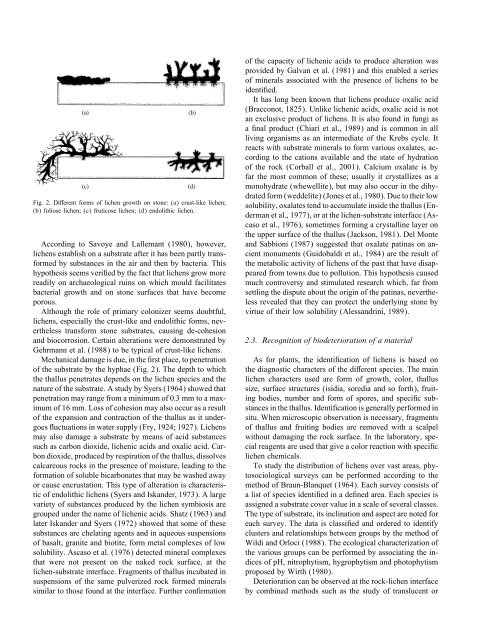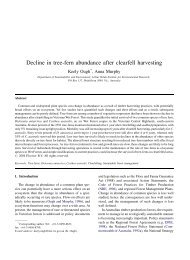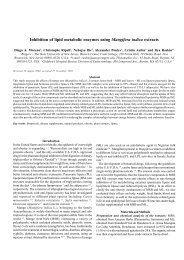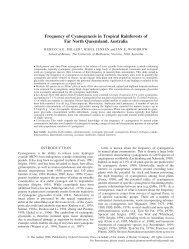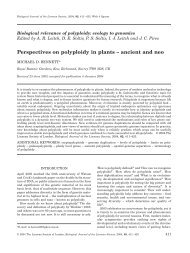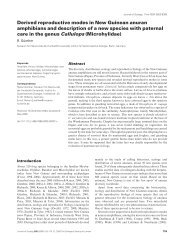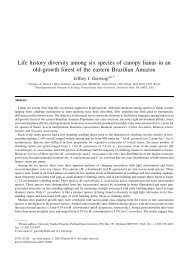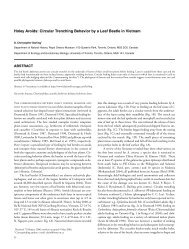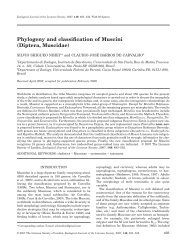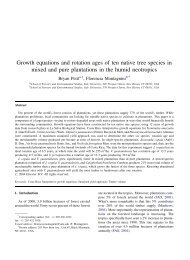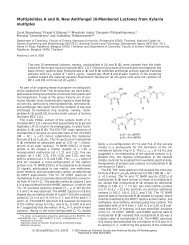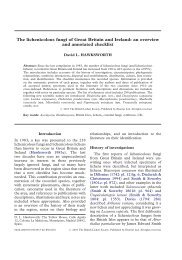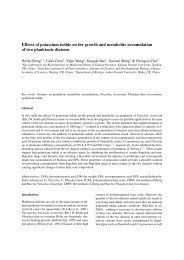Lichens and higher plants on stone: a review - AseanBiodiversity.info
Lichens and higher plants on stone: a review - AseanBiodiversity.info
Lichens and higher plants on stone: a review - AseanBiodiversity.info
Create successful ePaper yourself
Turn your PDF publications into a flip-book with our unique Google optimized e-Paper software.
Fig. 2. Di erent forms of lichen growth <strong>on</strong> st<strong>on</strong>e: (a) crust-like lichen;<br />
(b) foliose lichen; (c) fruticose lichen; (d) endolithic lichen.<br />
According to Savoye <str<strong>on</strong>g>and</str<strong>on</strong>g> Lallemant (1980), however,<br />
lichens establish <strong>on</strong> a substrate after it has been partly transformed<br />
by substances in the air <str<strong>on</strong>g>and</str<strong>on</strong>g> then by bacteria. This<br />
hypothesis seems veri ed by the fact that lichens grow more<br />
readily <strong>on</strong> archaeological ruins <strong>on</strong> which mould facilitates<br />
bacterial growth <str<strong>on</strong>g>and</str<strong>on</strong>g> <strong>on</strong> st<strong>on</strong>e surfaces that have become<br />
porous.<br />
Although the role of primary col<strong>on</strong>izer seems doubtful,<br />
lichens, especially the crust-like <str<strong>on</strong>g>and</str<strong>on</strong>g> endolithic forms, nevertheless<br />
transform st<strong>on</strong>e substrates, causing de-cohesi<strong>on</strong><br />
<str<strong>on</strong>g>and</str<strong>on</strong>g> biocorrosi<strong>on</strong>. Certain alterati<strong>on</strong>s were dem<strong>on</strong>strated by<br />
Gehrmann et al. (1988) to be typical of crust-like lichens.<br />
Mechanical damage is due, in the rst place, to penetrati<strong>on</strong><br />
of the substrate by the hyphae (Fig. 2). The depth to which<br />
the thallus penetrates depends <strong>on</strong> the lichen species <str<strong>on</strong>g>and</str<strong>on</strong>g> the<br />
nature of the substrate. A study by Syers (1964) showed that<br />
penetrati<strong>on</strong> may range from a minimum of 0:3 mm to a maximum<br />
of 16 mm. Loss of cohesi<strong>on</strong> may also occur as a result<br />
of the expansi<strong>on</strong> <str<strong>on</strong>g>and</str<strong>on</strong>g> c<strong>on</strong>tracti<strong>on</strong> of the thallus as it undergoes<br />
uctuati<strong>on</strong>s in water supply (Fry, 1924; 1927). <str<strong>on</strong>g>Lichens</str<strong>on</strong>g><br />
may also damage a substrate by means of acid substances<br />
suchas carb<strong>on</strong> dioxide, lichenic acids <str<strong>on</strong>g>and</str<strong>on</strong>g> oxalic acid. Carb<strong>on</strong><br />
dioxide, produced by respirati<strong>on</strong> of the thallus, dissolves<br />
calcareous rocks in the presence of moisture, leading to the<br />
formati<strong>on</strong> of soluble bicarb<strong>on</strong>ates that may be washed away<br />
or cause encrustati<strong>on</strong>. This type of alterati<strong>on</strong> is characteristic<br />
of endolithic lichens (Syers <str<strong>on</strong>g>and</str<strong>on</strong>g> Isk<str<strong>on</strong>g>and</str<strong>on</strong>g>er, 1973). A large<br />
variety of substances produced by the lichen symbiosis are<br />
grouped under the name of lichenic acids. Shatz (1963) <str<strong>on</strong>g>and</str<strong>on</strong>g><br />
later Isk<str<strong>on</strong>g>and</str<strong>on</strong>g>er <str<strong>on</strong>g>and</str<strong>on</strong>g> Syers (1972) showed that some of these<br />
substances are chelating agents <str<strong>on</strong>g>and</str<strong>on</strong>g> in aqueous suspensi<strong>on</strong>s<br />
of basalt, granite <str<strong>on</strong>g>and</str<strong>on</strong>g> biotite, form metal complexes of low<br />
solubility. Ascaso et al. (1976) detected mineral complexes<br />
that were not present <strong>on</strong> the naked rock surface, at the<br />
lichen-substrate interface. Fragments of thallus incubated in<br />
suspensi<strong>on</strong>s of the same pulverized rock formed minerals<br />
similar to those found at the interface. Further c<strong>on</strong> rmati<strong>on</strong><br />
of the capacity of lichenic acids to produce alterati<strong>on</strong> was<br />
provided by Galvan et al. (1981) <str<strong>on</strong>g>and</str<strong>on</strong>g> this enabled a series<br />
of minerals associated with the presence of lichens to be<br />
identi ed.<br />
It has l<strong>on</strong>g been known that lichens produce oxalic acid<br />
(Bracc<strong>on</strong>ot, 1825). Unlike lichenic acids, oxalic acid is not<br />
an exclusive product of lichens. It is also found in fungi as<br />
a nal product (Chiari et al., 1989) <str<strong>on</strong>g>and</str<strong>on</strong>g> is comm<strong>on</strong> in all<br />
living organisms as an intermediate of the Krebs cycle. It<br />
reacts withsubstrate minerals to form various oxalates, according<br />
to the cati<strong>on</strong>s available <str<strong>on</strong>g>and</str<strong>on</strong>g> the state of hydrati<strong>on</strong><br />
of the rock (Corball et al., 2001). Calcium oxalate is by<br />
far the most comm<strong>on</strong> of these; usually it crystallizes as a<br />
m<strong>on</strong>ohydrate (whewellite), but may also occur in the dihydrated<br />
form (weddelite) (J<strong>on</strong>es et al., 1980). Due to their low<br />
solubility, oxalates tend to accumulate inside the thallus (Enderman<br />
et al., 1977), or at the lichen-substrate interface (Ascaso<br />
et al., 1976), sometimes forming a crystalline layer <strong>on</strong><br />
the upper surface of the thallus (Jacks<strong>on</strong>, 1981). Del M<strong>on</strong>te<br />
<str<strong>on</strong>g>and</str<strong>on</strong>g> Sabbi<strong>on</strong>i (1987) suggested that oxalate patinas <strong>on</strong> ancient<br />
m<strong>on</strong>uments (Guidobaldi et al., 1984) are the result of<br />
the metabolic activity of lichens of the past that have disappeared<br />
from towns due to polluti<strong>on</strong>. This hypothesis caused<br />
much c<strong>on</strong>troversy <str<strong>on</strong>g>and</str<strong>on</strong>g> stimulated research which, far from<br />
settling the dispute about the origin of the patinas, nevertheless<br />
revealed that they can protect the underlying st<strong>on</strong>e by<br />
virtue of their low solubility (Aless<str<strong>on</strong>g>and</str<strong>on</strong>g>rini, 1989).<br />
2.3. Recogniti<strong>on</strong> of biodeteriorati<strong>on</strong> of a material<br />
As for <str<strong>on</strong>g>plants</str<strong>on</strong>g>, the identi cati<strong>on</strong> of lichens is based <strong>on</strong><br />
the diagnostic characters of the di erent species. The main<br />
lichen characters used are form of growth, color, thallus<br />
size, surface structures (isidia, soredia <str<strong>on</strong>g>and</str<strong>on</strong>g> so forth), fruiting<br />
bodies, number <str<strong>on</strong>g>and</str<strong>on</strong>g> form of spores, <str<strong>on</strong>g>and</str<strong>on</strong>g> speci c substances<br />
in the thallus. Identi cati<strong>on</strong> is generally performed in<br />
situ. When microscopic observati<strong>on</strong> is necessary, fragments<br />
of thallus <str<strong>on</strong>g>and</str<strong>on</strong>g> fruiting bodies are removed with a scalpel<br />
without damaging the rock surface. In the laboratory, special<br />
reagents are used that give a color reacti<strong>on</strong> with speci c<br />
lichen chemicals.<br />
To study the distributi<strong>on</strong> of lichens over vast areas, phytosociological<br />
surveys can be performed according to the<br />
method of Braun-Blanquet (1964). Each survey c<strong>on</strong>sists of<br />
a list of species identi ed in a de ned area. Eachspecies is<br />
assigned a substrate cover value in a scale of several classes.<br />
The type of substrate, its inclinati<strong>on</strong> <str<strong>on</strong>g>and</str<strong>on</strong>g> aspect are noted for<br />
eachsurvey. The data is classi ed <str<strong>on</strong>g>and</str<strong>on</strong>g> ordered to identify<br />
clusters <str<strong>on</strong>g>and</str<strong>on</strong>g> relati<strong>on</strong>ships between groups by the method of<br />
Wildi <str<strong>on</strong>g>and</str<strong>on</strong>g> Orloci (1988). The ecological characterizati<strong>on</strong> of<br />
the various groups can be performed by associating the indices<br />
of pH, nitrophytism, hygrophytism <str<strong>on</strong>g>and</str<strong>on</strong>g> photophytism<br />
proposed by Wirth(1980).<br />
Deteriorati<strong>on</strong> can be observed at the rock-lichen interface<br />
by combined methods such as the study of translucent or


